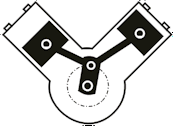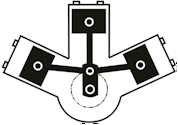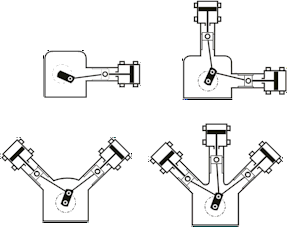 Fig. 3.1: Symbol for piston compressor
Fig. 3.1: Symbol for piston compressor | Piston compressors draw in air by way of pistons moving up and down, compress it and then push it out. The processes control induction and pressure valves.
By arranging several compression stages in series it is possible to generate various pressures, and differing quantities of air can be generated by using several cylinders.
|
 Fig. 3.2: Op. diagram of plunger compressor
Fig. 3.2: Op. diagram of plunger compressor
| Plunger compressor
On plunger compressors, the piston is connected directly to the crankshaft via the con-rod. |
| Crosshead compressor
The piston is powered by a piston rod and that by the crosshead.
Properties of piston compressors:
- Highly efficient
- High pressures
|
Fig. 3.3: Op. diagram of crosshead compressor
 Fig. 3.4: V-type plunger compressor
Fig. 3.4: V-type plunger compressor
 Fig. 3.5: W-type plunger compressor
Fig. 3.5: W-type plunger compressor
 Fig. 3.6: Crosshead compressors
Horizontal, L-type, V-type, W-type
Fig. 3.6: Crosshead compressors
Horizontal, L-type, V-type, W-type
| The piston compressors are differentiated according to the arrangement of their cylinders:
- Vertical cylinders.
No stress on the piston or piston ring through the weight of the piston.
Small base area.
- Horizontal cylinders.
Only as multi-cylinder compressor in Boxer construction. Low forces of gravity. This benefit is only noticeable when output is greater.
- V-, W- or L-type compressors.
Good mechanical balance.
Low space requirement.
|